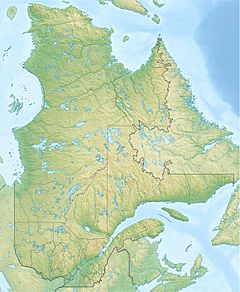Laval River facts for kids
Quick facts for kids Laval River |
|
|---|---|
| Native name | Rivière Laval |
| Country | Canada |
| Province | Quebec |
| Region | Côte-Nord |
| RCM | La Haute-Côte-Nord |
| Physical characteristics | |
| Main source | Lac Septembre 49°06′42″N 69°18′00″W / 49.1116667°N 69.3°W |
| River mouth | 48°46′23″N 69°03′01″W / 48.773104°N 69.050295°W |
The Laval River, known as Rivière Laval in French, is a special river in the Côte-Nord region of Quebec, Canada. It is famous for its salmon.
Contents
Where is the Laval River?
The Laval River starts in Forestville, a town in Quebec. This area is part of La Haute-Côte-Nord.
Following the River's Path
A road called Route 385 runs close to the river. This makes it easy to see parts of the Laval River. The name "Laval River" became official on December 5, 1968.
The River's Journey
The Laval River begins its journey in a lake called Lac Septembre. From there, it flows mostly towards the southeast.
Lakes Along the Way
The river passes through several lakes. These include Lac Roger, Lac Kinney, Lac Stanley, and Lac Laval. It enters Lac Laval from the southwest and leaves from the southeast. Lac Laval is quite large, about 656 hectares (1,621 acres). Sometimes, people think Lac Laval is where the river actually starts.
After Lac Laval, the river continues through Lac Éric and Lac Courdeau. It then enters a flat valley. Here, other smaller rivers, like the Adam River, join it. Water from Lac MacDonald and Lac Madeleine also flows into the Laval River. Finally, the river reaches Lac à Jacques.
The Final Stretch
Below Lac à Jacques, the river has some fast-moving sections. It then flows under Quebec Route 138 at a place called Pont-Laval, which is close to where it meets the ocean.
A Special Forest
Near the river's mouth, there is a special place called the Laval River Rare Forest. It covers about 33 hectares (82 acres). This forest is unique because it has many red pine trees (Pinus resinosa). These trees are very rare in the Côte-Nord region.
The Laval River eventually flows into the Saint Lawrence River. It enters a part of the Saint Lawrence called Baie Laval, just north of Forestville. Pointe Laval is a point of land at the bay's entrance, and Île Laval is a small island in the bay.
River Characteristics
The river's flow changes a lot, sometimes slow and sometimes fast. The riverbed is often dark, and the water is not always clear. Some of the deeper parts of the river look black. After it rains, the river's water level and color can change quite a bit.
Fishing in the Laval River
The Laval River is a popular spot for fishing. For many years, a paper company owned the fishing rights. But then, the Quebec government made the river a wildlife reserve.
Managing the River for Fishing
In 1968, the Forestville Hunting and Fishing Association was created. In 1978, this group became in charge of a large reserve called the Forestville ZEC. A ZEC is a "controlled use zone" where activities like hunting and fishing are managed. The Association started managing the Laval River for fishing in 1980. Today, the River Laval ZEC is still managed by this group.
The river has 67 pools where you can find salmon and 45 pools for trout. Both the Atlantic salmon (Salmo salar) and the sea trout (Salmo trutta) are found here. These fish are often larger than average. Lac à Jacques is also home to excellent northern pike (Esox lucius).
Protecting Salmon
In 2015, the Quebec government started a special program for sport fishing on 16 salmon rivers, including the Laval River. This program encouraged "catch-and-release" for large salmon. This means anglers would catch the fish and then release them back into the water. This helps protect the fish population.
Some groups, like the Quebec Atlantic Salmon Federation, felt that these measures were not enough. They believed that catch-and-release should be used on almost all rivers to protect salmon for the future. This was because the Atlantic salmon population was decreasing quickly.
Studying the River's Fish
In 2019, a group called the Upper North Shore Watershed Agency studied the fish in the Laval River's smaller streams. They had already looked at the salmon spawning grounds in 2018. They found that salmon could easily travel up one of the smaller streams to lay their eggs. They also found three other streams that salmon might be able to use. By understanding where salmon reproduce, they can better protect the river and its fish.


